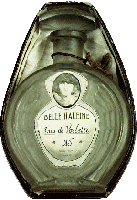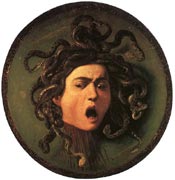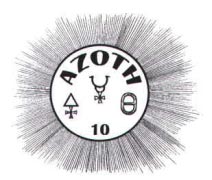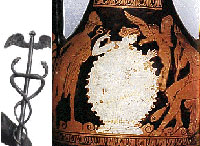by
Mauricio Cruz
|
||||||||||||||||||||||||||||
|
3 But behind the rapid wings and the weightless foam, stands always the sea, a sea that is indicated in various locations: 1. the location of Monte Carlo itself; 2. in the nature of the shaving foam transformed into Aphros, ‘sea-foam’; 3. hidden behind the insistent tongue twister moustiques domestiques demi-stock that is repeated 150 times in green ink(33) much like a ‘security slogan’ in the background of the Obligation. The phrase is nearly identical to Nous livrons à domicile /des moustiques domestiques /[demi-stock](34), the same phrase that appears completed, three years later, on one of the discs of Anemic Cinema(35): “ON DEMANDE DES MOUSTIQUES DOMESTIQUES [DEMI-STOCK] POUR LA CURE D’AZOTE SUR LA CÔTE D’ÁZUR.” That “cure d’azote sur la Côte d’Azur”, can also be found camouflaged in the back of the Obligation’s statutes: Art. 1er. –La Société a pour object:
Azoth necessarily refers us to alchemy (a metaphoric background which, together with modern science and psychology, abounds in Duchampian exegesis) where the three basic symbolic substances (mercury, sulphur, and salt) are complemented with a fourth one, the mysterious vital principle known as Azoth. This primus agens is seen by some as “the invisible, eternal fire; others as electricity; still others as magnetism. Transcendentalists refer to it as the astral light.” Also described as “primitive air” and as “the Waters or Crystalline Chaotic Sea”(37), the key virtue of this mysterious ingredient consists in bonding together the physical matter represented in the three basic substances. And it is this unifying virtue that causes some to identify it as “unconditional love”. A sort of generic glue whose powerful and subtle nature cannot be wholly scrutinized. Existing documents allow us to suppose that around the time of the Monte Carlo Bond, Duchamp was going through a particularly critical moment. And although (as usual) his reserved nature strategically covers the details, in the sixties, towards the end of his life, he writes: “Since 1923 I consider myself as an artist ‘défroqué’ [unfrocked].”(38) “Thus, after 1923, -according to Jean Clair- came a time of disillusion and apathy. Duchamp défroqué. Duchamp idle. Duchamp the chess player.”(39) In a maternal approach, Katherine Dreier, one of his patrons, considered that the psychological atmosphere of a casino was detrimental “for a person as sensitive as Marcel”. And Breton: “How could a man so intelligent –the most profoundly original man in the century, according to Breton- devote his time and energy to such trivialities? Searching for an explanation, Breton could only conclude that some hidden malaise must be at work –what he had described to Jacques Doucet as Duchamp’s ‘desperate’ state of mind.”(40) Nevertheless, in the spring of 1924, before the Monte Carlo Bond, Duchamp writes to Jacques Doucet after one month at the Riviera during a chess tournament: “The climate suits me perfectly, I would love to live here.”(41) Therapy? ‘Oxygenation’ in Monte Carlo? Perhaps the encapsulated air in the foam is of the same nature as the Air de Paris, his readymade from the early 1920s. Originally a glass phial filled with physiological serum -bought and emptied by Duchamp in a Parisian pharmacy, and then presented as a souvenir to the Arensberg upon his return to New York - Air de Paris can be seen as a translation of the 50cc of Parisian air into a ‘psychological serum’. All this, the same year when Rrose Sélavy is ‘born’.
After her first manifestation retaining the copyright of Fresh Widow (French Window) — a French window condemned in its visibility by glass panes covered in brilliant black leather— Rrose Sélavy is presented visually on the name and label of Un Air Embaumé originally a perfume of Rigaud rebaptized as Belle Haleine, Eau de Voilette. (Fig. 14) Another psychological serum, although rather lugubrious, judging from the initial case: a small coffin where the image of the rigorous and concentrated transvestite slides through. This problematic identity foreshadows the foaming Monte Carlo portrait, and allows us to imagine the deep significance behind the "exploitation of Thirty and Forty and other mines of the Côte d'Azur under the deliberation of its Administrative Council." In other words, under the deliberation of its only two members; what Duchamp calls on other occasions "un petit jeu entre Je et Moi". And apropos of dualities, the mercurial portrait, as any medal, must have another face. The opposite image -in my view- is not the beautiful and radiant head of John the Baptist or that of the sedated Holofernes as has been suggested, but is instead the image of that who lays fearful of her own reflection upon Perseus’s shield: Medusa. Deadly force that petrifies whoever looks at her. A true evil eye. An evil ‘Voilette’. Why Medusa? Because of Perseus: “Mercurial, aerial, Perseus is unique in being able to conjure the gravity of things, the opacity of chaos, the numbness of Saturn’s weighty world …there where the spirit, too tied to earth, becomes frozen in its fear of petrification.”(42) Because Perseus, like Mercury, carries on his helmet and sandals the same rapid and ethereal wings.(43) And also, because in the axis of that tree, the serpent twirls around like a Caduceus, symbol of medicine [MD] and transformative power. Another indispensable attribute of Mercury, where the two opposite animals, the bird and the serpent, determine the significance and polarity of the implicit process: the serpent as material energy associated with the ascendant spiral and the bird as liberated, spiritual form. The relationship with Perseus is then didactically illustrated at the moment when Perseus, his head covered with the winged helmet, exhibits Medusa’s severed head, sustaining her mangled hair made up of serpents in a symmetrical, mirror-like manner.(44) (Fig. 15)It is therefore
not beyond reason to suppose that the reverse of the circular self-portrait
in the Monte Carlo Bond (its corresponding negative image) is
Caravaggio’s image of Medusa (an actual shield) painted at the
end of the sixteenth century.(45)
Interestingly, it is often said that Caravaggio used his own
features as the model for this round image, while gesticulating in front
of a mirror. Thus allowing us to propose the following iconographic
relationship: (Figs. 16, 17 & 18)
In this sequence, the ‘ petrification’, the detention or apathy felt by Duchamp in the period following The Bride Stripped Bare would necessitate a certain ‘ breathing space...or draft of air’ (a courant d’air) that could revitalize his faculties as ‘respirator’: “I like living, breathing, better than working (...) if you wish, my art would be that of living: each second, each breath is a work which is inscribed nowhere, which is neither visual nor cerebral. It’s a sort of constant euphoria.”(46) In this particular circumstance, the nature and secret of the euphoric and constant element could not be found in the habitual cultural ‘nutrition’ -that is in his reinscription into artistic and social activity- but in the timeless properties of an essential symbolic scenery: the sea, and chance. The crystalline, chaotic waters; effectively, a cure d’azote sure la Côte d’Azur – geographical location of immersion and baptism where the annexed feminine (Aphrodite/Rrose) establishes a natural and mythic complicity. An element in front of which, reason and logic (with all their intentions and grueling calculations) see themselves compelled to negotiate between the metaphoric territories of the combative (masculine) chess, and the roulette’s whimsical chance. The serum, the glass bubble with its ethereal air of Paris is nothing else than a necessary ‘azoth’, a sensitive order freely incarnated in that alter-ego with the name of a rose, a flower imbedded with the liberating energy of eros. Thus we can imagine graphically how Caravaggio’s asphyxiating Medusa incorporates the revitalizing virtue of azoth as a kind of medicinal potion, transforming itself. The result may be fully appreciated in the Monte Carlo ‘cameo’ with the foaming head encrusted in the solar aura of the roulette.
L’Obligation d’un Possible? A feasible Bond? In any case, a secret unconscious martingale throwing its bet over the lingering target of a much-needed self-regeneration. A new birth of a Je and a Moi unified as a pearl in its shell generated by the Chaotic 'gambling' Sea of Monte Carlo. A very personal system where Duchamp nevertheless, “never wins nor loses”(47) , in natural compliance with that central point, indifferent, of the “et-qui-libre”(48) hermaphrodite. On the other hand, the synthetic figure of the Bond, the underlying instrument to the whole therapeutic process is none other than the Caduceus, (Fig. 19) the winged rod with the two symmetrically intertwining serpents. This object may be associated - via Tiresias - with the alternating masculine/feminine sex, and with the oracular gift of prophecy. In this context, the story of Tiresias is quite pertinent:
Vedi Tiresia che mutò sembiante (…) In more recent times, in 1944, Poulenc created a musical adaptation of Apollinaire’s 1903 piece Les Mamelles de Tiresias (Tiresias’s Breasts). Both versions remove themselves from the original tale in a significant and burlesque manner, transposing the hermaphrodite sexual alternation into domestic terms. The modern narrators relate a decline in France’s birth rates due to the feminine emancipation of Thérèse/Tirésias, a loss compensated by her husband who gave birth to 40,000 children in one day… In any case, Poulenc decided to transfer the action of Apollinaire’s version from Zanzibar, an island near the African east coast, to Zanzibar, a supposed population on the French Riviera somewhere between Nice and Monte Carlo. All because he adored Monte Carlo and also because “that was where Apollinaire spent the first 15 years of his life”, adding that this was a place “sufficiently tropical for a Parisian like myself.”(50) In the end, Duchamp did not become an addict to roulette, but instead submerged himself for the rest of his days in the sophisticated infra-mince labyrinth of the strategic possibilities offered by chess. In relation to Monte Carlo, in 1952 he sums up his adventure by saying: “Artists throughout history are like gamblers in Monte-Carlo and in the blind lottery some are picked out while others are ruined... it all happens according to random chance. Artists who during their lifetime manage to get their stuff noticed are excellent traveling salesmen but that does not guarantee a thing as far as the immortality of their work is concerned. And even posterity is a terrible bitch who cheats some and reinstates others, and reserves the right to change her mind again every 50 years." But perhaps, the clue for transcending history and not simply being subject to random chance is as claimed by a commercial slogan of some web page: “with caduceus you’re not a number… you are an individual!”.(51) In other words, you must pronounce Zanzibar! Zanzibar! "quickly enough, until the letters become confounded".
Notes
Fig.
13-14, 18 |
||||||||||||||||||||||||||||



















